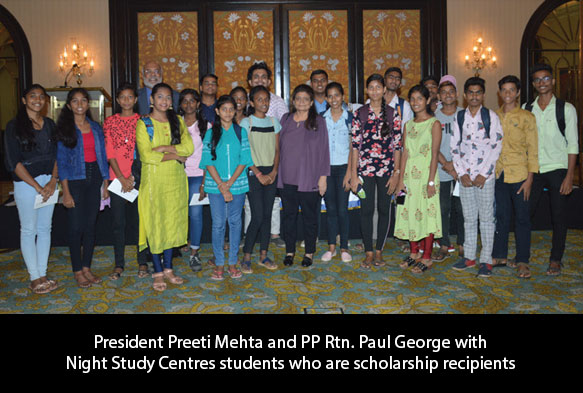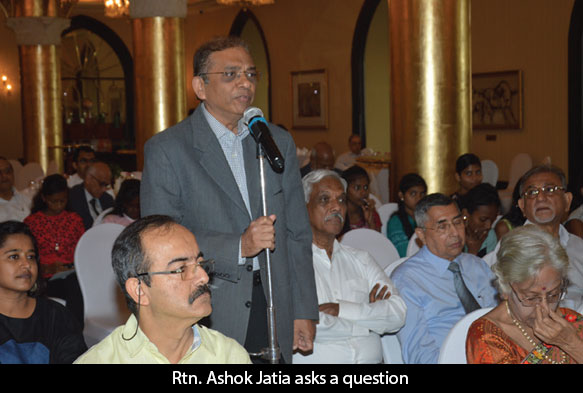
Arms And The Man
Sarosh Bana, Executive Editor, Business India, speaks about the race to arm India
AT LAST Tuesday’s meeting, Sarosh Bana, Executive Editor, Business India, spoke about ‘Arming India: Concerns of National Security’. He said: As far as India is concerned, defence has a wide connotation. India was the largest importer of arms in 2018, just behind Saudi Arabia according to SIPRI (Stockholm International Peace Research Institute) India.
Sarosh also reminded Rotarians that India has the second-largest standing army (3.5 million) in the world, just behind Russia (3.6 mn). He added: “It also has second-largest population in the world after China and is the seventh-largest country in the world. This means that it has a lot of people and a lot of territory to defend. About 1.33 million people of various ethnic and religious diversities, caste and creed, all crammed together in an area which is just 3.29 sq km territory. It has two adversaries on the frontiers and yet the country has held itself remarkably well, which is a tribute to our nation. We have two neighbours that are particularly hostile towards us – China and Pakistan. All of the three countries are nuclear powers and have systems that can deliver nuclear warheads at targeted sites.”
“We have threats from China and Pakistan, but it has to be borne in mind that if we have any hostilities breaking out with Pakistan, it will most probably bring in China as an interceder and that will be a little difficult because China has strong and formidable armed forces.”
“We should also realise that Indian and Pakistani troops square up virtually at the Siachen glacier, the highest, harshest and toughest battlefield in the world. Most of the soldiers died not of bullets but due to the harsh weather.”
“We often have Chinese troops invading our territory across the borders and making pickets there and threatening our troops and villagers and making access roads and helipads. Often, there is nothing much we can do about that. The beautiful terrain of Jammu and Kashmir has been completely ravaged by years of cross-border terrorism. So we have to deal with all these circumstances. The situation is compelling for a more massive modernization programme for our armed forces and making India the largest purchaser of arms.”
Russia had been the largest provider of arms for India but Sarosh Bana brought to light some interesting trends over the last few years: “The export of arms from Russia to India in the last five years was seen going down from 76 per cent to 58 per cent. And, in the same five years, arms from America to India have grown five-fold. American arms today constituted 50 per cent of India’s armory. This is the reason we have to play to the Americans and keep good with Trump because we have great aspirations and Americans can help us validate those aspirations.”
“We have seen India stretching out its maritime domain from east Africa to Malacca and seeking to heighten its profile and presence in the Indo-Pacific by allying with other powers. Washington has, for instance, returned the favour by renaming the US PACOM which is the United States’ President’s command, the largest command and which governs a huge territory of the world, to US-Indo PACOM.”
“One of our priorities is to fast track the infantry modernisation; another key priority is to induct 110 fighter aircrafts to bridge the gap of our requirements. Navy has big plans for us; they now have 132 ships, 220 aircrafts, 15 submarines and want to heighten these. It’s a massive plan. One also has to keep in mind that most of our procured plans are years and decades behind schedule and that is the reason we will end up in a situation where when we replace certain platforms like MIGs from Russian in the 1980s to Rafael. The time by which we acquire new aircraft, it is already obsolete alongside the obsolete platforms that we are replacing. It is a very sad situation.”
“India’s doctrine has always been minimal credible deterrence but our defence Minister Rajnath Singh made a comment this year that in the future we need to review this policy because we always talked about the no firstuse policy and we might renew it as we were opposed to mutually-assured destruction. So we have to think in terms of that.”
“India is the only non-permanent UNSC member country that has a sea-based nuclear deterrent. According to the US Federation of Nuclear Scientists, India has 130-140 nuclear warheads, Pakistan has 140-150 and China has 280 nuclear warheads. To manage and administer the nuclear stockpile, the Vajpayee government in 2003 set up Strategic Force’s Command which comes under the nuclear command authority. The hostilities confronting India have greatly strained national resources, diverting vital funding to the military at the cost of impoverished millions.”
“The Union Budget 2019-20 lavished a phenomenal Rs 4.31 lakh crore on defence which is four and a half times on education, seven times allocation on public health and three times of allocation on agriculture. Apart from that, the Ministry of Home Affairs secured 1.20 lakh crore to oversee internal security. People say that India’s defence budget is proportionally far lower than that of Pakistan or China when measured in proportion to GDP.”
“Recently, a newspaper reported that not one of the major Make in India projects in the defence arena, from new generation submarines Minesweeper to infantry combat vehicles, transport and fighter aircrafts, have taken off in the last six years, which is a very sorry state. These long-pending projects are collectively worth Rs 3 and a half crore and they have been stuck at various stages. Also, in the Indian context, defence procurement is largely apolitical rather than one premised on military and security considerations. This has a deep impact on our force levels and, by extension, on our national defence.”
“Dassault Aviation, Rafale Jet fighter deal is the most famous case in point. There are many questions that this case raised, primarily, because the government maintained that it is the government that professes transparency in governance and transparency in decision making. You may all recall Prime Minister Modi had gone to France to sign this deal for 7.87 billion Euros and he somehow annulled the previous deal made by the UPA government which was for 126 Rafale aircraft at a much cheaper price.”
“Why was it done in secrecy?
The Parliament was not informed, it was not discussed in the Parliament, neither did the Finance Minister or the defence minister know anything about this. When Modi was actually signing the deal, the then Defence Minister Manohar Parrikar was inaugurating a fisheries exhibition in Goa. So, eyebrows were raised. Rafale was chosen from a grouping of six contenders. One may recall that the Rafale deal was actually because the Indian Air Force in 2005 gave an undertaking that they immediately required a large assemblage of aircraft to fill in the gap left by the obsolete MiG aircrafts of 1980s to fight wars on two fronts. Thus, although today we have the sanctioned strength of 44 squadrons in Indian Air force, we only have 26 and in the next 2 years we will only have 26 squadrons. That’s a huge gap to fill.”
“India’s Defence ministry acknowledges that military population has become the key driver in the Indo-US bilateral relations. In 2016, US recognised India as a major defence partner to liberalise arms and technology transfer. The US also conducts more military exercises with India than with any other country, the US senate also recently passed a diversion of National Defence Authorization Act that confers on India the status of a NATO ally.”
“As far as air strikes in Balakot are concerned, Balakot somehow betrayed a glaring inadequacy in Indian Armed forces because in the first two days, India had already lost one plane, a MiG 21, India also had one of its pilots captured by the Pakistanis and the worse was that 100 km away from the launch of air strike, one helicopter MiG 17 of India was caught down by friendly fire and it led to the death of six security personnel and one person on the ground. So we were ill prepared foreign exercise of this sort. This was only in the first two days so imagine what if it would have been a fullfledged war and the Chinese did not even intervene at
Sarosh Bana: Diplomacy plays a very important role in military strategy
this point. Adding to this was the then air force Chief making a statement that if we had Rafales, the entire situation would have been very different. It is a very dangerous statement to make for an air chief because there are many implications to that. One is, what was he trying to make a comment about the Indian air force that the fleet at his disposal is not measuring up to the fleet of his enemies? Second, he was making a political statement that endorsed a deal which was signed.”
Sarosh concluded by saying, today, India needs to focus more on future technologies. people say that the next battle will be fought more on the internet than on the battlefield because cyber warfare can entirely disable and knockout your infrastructure. It can have a mark on your armed forces preparation and capabilities. We have seen that many arms of Defence ministry has been hacked by cyber fosters, criminals from other countries. Even the Minister of State for Home has made a statement that we are leagues behind China as far as cyber war is concerned. The competition is ever increasing.
As far as the entire set up of defence ministry is concerned, We have come with a post of Chief of Defence staff for the three services to integrate them into decision making processes. It was originally proposed in 1982 but has finally taken shape now. The Chief of Defence will facilitate jointmanship and be a single point advisor for the Government of India. But India should also be aware that diplomacy plays a very important role in military strategy and it will be good for India to perceive a diplomatic path and to have amicable relations with our neighbourhood countries.










